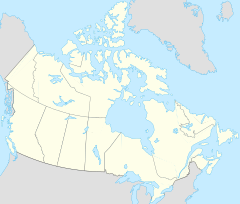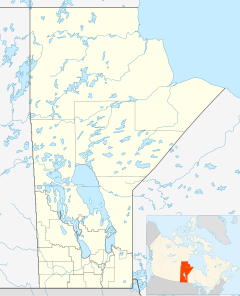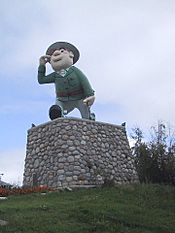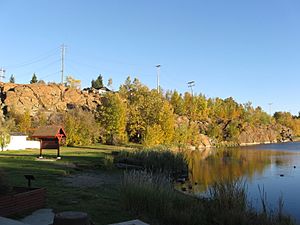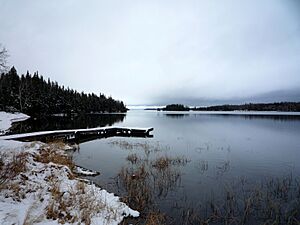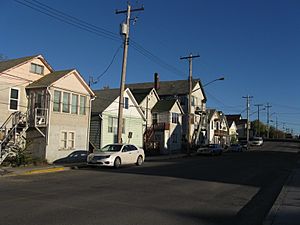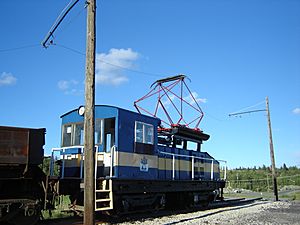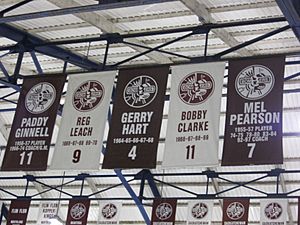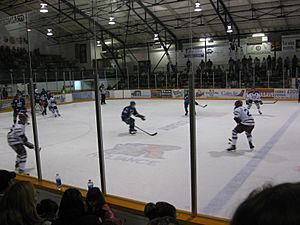Flin Flon facts for kids
Quick facts for kids
Flin Flon
|
||
|---|---|---|
|
City
|
||
| City of Flin Flon | ||
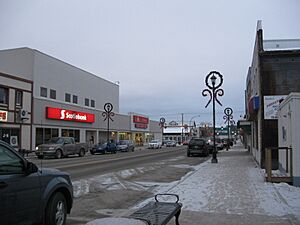
Main Street of Flin Flon
|
||
|
||
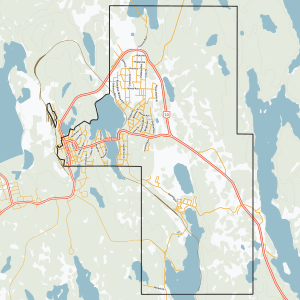
City boundaries
|
||
| Country | Canada | |
| Provinces | Manitoba and Saskatchewan |
|
| District (Saskatchewan) | Northern Saskatchewan Administration District | |
| Region (Manitoba) | Northern Manitoba | |
| Founded | 1927 | |
| Incorporated | January 1, 1933 | |
| Area | ||
| • Land | 11.55 km2 (4.46 sq mi) | |
| Elevation | 300 m (980 ft) | |
| Population
(2021)
|
||
| • Total | 5,099 | |
| Time zone | UTC-6 (CST) | |
| • Summer (DST) | UTC-5 (CDT) | |
| Forward sortation area |
R8A
|
|
| Area code(s) | 204 | |
| Website | http://www.cityofflinflon.ca/ | |
Flin Flon is a city in Canada that sits right on the border between two provinces: Manitoba and Saskatchewan. Most of the city is in Manitoba. In 2021, about 5,099 people lived there.
Flin Flon is known as a mining city. It was built to use the rich copper and zinc resources found nearby.
Contents
- What's in a Name? The Story of Flin Flon
- A Brief Look at Flin Flon's History
- Exploring Flin Flon's Geography
- Flin Flon's Population Over Time
- Getting Around Flin Flon: Transportation
- Flin Flon's Economy: Mining and More
- Arts and Culture in Flin Flon
- Sports and Recreation in Flin Flon
- Media in Flin Flon
- Notable People from Flin Flon
- See also
What's in a Name? The Story of Flin Flon
The city of Flin Flon got its unusual name from a book! It comes from the main character in a 1905 adventure novel called The Sunless City. The character, Josiah Flintabbatey Flonatin, explored an amazing underground world in his submarine.
A prospector named Tom Creighton supposedly found a copy of this book. When he discovered a lot of copper ore, he thought of the book. He called his discovery "Flin Flon's mine." The town that grew around this mine then took the name Flin Flon.
The character "Flinty" is very important to the city's identity. There's even a statue of him designed by cartoonist Al Capp. This statue is a popular landmark in Flin Flon.
A Brief Look at Flin Flon's History
Flin Flon was started in 1927 by a company called Hudson Bay Mining and Smelting (Hudbay). They wanted to mine the large amounts of copper and zinc in the area. In the late 1920s, Hudbay built a railway, a mine, a smelter (a place to process metal), and a power plant.
The town grew quickly in the 1930s. Many people who were struggling during the Great Depression came to Flin Flon looking for work in the mines. The town officially became a municipality on January 1, 1933, and then a city in 1970.
Flin Flon has continued to be a mining hub. Over the years, new mines have opened, adding to its industrial base. The city is also a popular place for tourists because of its beautiful scenery and nearby lakes.
Exploring Flin Flon's Geography
Flin Flon is unique because it's built across the border of Manitoba and Saskatchewan. Most of the city is in Manitoba. In 2016, about 4,982 people lived in the Manitoba part, and 203 lived in the Saskatchewan part.
Because of how the provincial border zig-zags, the Saskatchewan part of Flin Flon is actually south of the Manitoba part, not west. Some streets even cross the border!
For mail, everyone in Flin Flon uses a Manitoba postal code. However, for phone service, people in the Saskatchewan part use a Saskatchewan area code. This can sometimes cause issues with emergency services, as calls might go to a different dispatch center.
Flin Flon is often called "the city built on rock." This is because most of the city is on exposed Canadian Shield bedrock. This rocky ground means that farming is generally not possible here. In some parts of the city, water and sewer pipes have to be built above ground in special "sewer boxes" because there isn't enough soil to bury them.
Flin Flon's Climate: Hot Summers, Cold Winters
Flin Flon has a climate with big changes between seasons. Summers are warm, and winters are very cold. In January, the average low temperature is about -22.9°C (‑9.2°F). In July, the average high temperature is about 24.1°C (75.4°F).
The hottest temperature ever recorded in Flin Flon was 38.3°C (101°F) in July 1941. The coldest temperature ever recorded was -46.1°C (-51°F) in January 1930.
| Climate data for Flin Flon, 1981–2010 normals, extremes 1927–present | |||||||||||||
|---|---|---|---|---|---|---|---|---|---|---|---|---|---|
| Month | Jan | Feb | Mar | Apr | May | Jun | Jul | Aug | Sep | Oct | Nov | Dec | Year |
| Record high °C (°F) | 9.5 (49.1) |
11.7 (53.1) |
18.0 (64.4) |
29.4 (84.9) |
33.5 (92.3) |
36.0 (96.8) |
38.3 (100.9) |
35.6 (96.1) |
32.5 (90.5) |
25.0 (77.0) |
15.5 (59.9) |
8.3 (46.9) |
38.3 (100.9) |
| Mean daily maximum °C (°F) | −14.7 (5.5) |
−10.2 (13.6) |
−2.1 (28.2) |
7.3 (45.1) |
15.0 (59.0) |
21.1 (70.0) |
24.1 (75.4) |
22.6 (72.7) |
15.0 (59.0) |
6.3 (43.3) |
−5.0 (23.0) |
−12.4 (9.7) |
5.6 (42.1) |
| Daily mean °C (°F) | −18.9 (−2.0) |
−14.9 (5.2) |
−7.6 (18.3) |
1.8 (35.2) |
9.4 (48.9) |
15.8 (60.4) |
18.9 (66.0) |
17.5 (63.5) |
10.8 (51.4) |
3.0 (37.4) |
−8.0 (17.6) |
−16.2 (2.8) |
1.0 (33.8) |
| Mean daily minimum °C (°F) | −22.9 (−9.2) |
−19.6 (−3.3) |
−13.0 (8.6) |
−3.6 (25.5) |
3.8 (38.8) |
10.4 (50.7) |
13.6 (56.5) |
12.4 (54.3) |
6.5 (43.7) |
−0.4 (31.3) |
−11.0 (12.2) |
−20.0 (−4.0) |
−3.6 (25.5) |
| Record low °C (°F) | −46.1 (−51.0) |
−43.3 (−45.9) |
−40.0 (−40.0) |
−29.4 (−20.9) |
−15.0 (5.0) |
−2.8 (27.0) |
0.0 (32.0) |
0.0 (32.0) |
−10.0 (14.0) |
−21.7 (−7.1) |
−34.4 (−29.9) |
−43.3 (−45.9) |
−46.1 (−51.0) |
| Average precipitation mm (inches) | 17.5 (0.69) |
16.7 (0.66) |
15.1 (0.59) |
20.3 (0.80) |
40.9 (1.61) |
69.0 (2.72) |
77.9 (3.07) |
63.7 (2.51) |
63.4 (2.50) |
29.0 (1.14) |
21.7 (0.85) |
22.5 (0.89) |
457.6 (18.02) |
| Average rainfall mm (inches) | 0.0 (0.0) |
0.0 (0.0) |
0.2 (0.01) |
7.9 (0.31) |
39.3 (1.55) |
69.3 (2.73) |
77.9 (3.07) |
63.7 (2.51) |
64.2 (2.53) |
21.0 (0.83) |
1.1 (0.04) |
0.0 (0.0) |
344.5 (13.56) |
| Average snowfall cm (inches) | 17.5 (6.9) |
16.7 (6.6) |
15.0 (5.9) |
12.4 (4.9) |
1.6 (0.6) |
0.0 (0.0) |
0.0 (0.0) |
0.0 (0.0) |
0.7 (0.3) |
8.1 (3.2) |
20.6 (8.1) |
22.9 (9.0) |
115.5 (45.5) |
| Average precipitation days (≥ 0.2 mm) | 6.6 | 5.6 | 4.6 | 4.6 | 8.6 | 9.9 | 12.2 | 10.4 | 10.6 | 7.4 | 6.4 | 6.6 | 93.5 |
| Average rainy days (≥ 0.2 mm) | 0.0 | 0.0 | 0.11 | 2.1 | 8.4 | 10.0 | 12.2 | 10.4 | 10.5 | 5.4 | 0.36 | 0.0 | 59.3 |
| Average snowy days (≥ 0.2 cm) | 7.0 | 5.6 | 4.6 | 2.5 | 0.38 | 0.04 | 0.0 | 0.0 | 0.20 | 2.3 | 6.0 | 6.7 | 35.3 |
| Source: Environment Canada | |||||||||||||
Flin Flon's Population Over Time
| Combined population history of both portions of the City of Flin Flon | ||
|---|---|---|
| Year | Pop. | ±% |
| 1931 | 2,374 | — |
| 1941 | 8,860 | +273.2% |
| 1951 | 9,899 | +11.7% |
| 1956 | 10,771 | +8.8% |
| 1961 | 11,106 | +3.1% |
| 1966 | 10,201 | −8.1% |
| 1971 | 9,344 | −8.4% |
| 1976 | 8,560 | −8.4% |
| 1981 | 8,261 | −3.5% |
| 1986 | 7,591 | −8.1% |
| 1991 | 7,449 | −1.9% |
| 1996 | 6,861 | −7.9% |
| 2001 | 6,267 | −8.7% |
| 2006 | 5,836 | −6.9% |
| 2011 | 5,634 | −3.5% |
| 2016 | 5,185 | −8.0% |
| 2021 | 5,099 | −1.7% |
|
|||||||||||||||||||||||||||||||||||||||||||||||||||||||||
|
|||||||||||||||||||||||||||||||||||||||||||||||||||||||||
In the 2021 Census, the Manitoba part of Flin Flon had 4,940 people. The Saskatchewan part had 159 people. This means the total population was 5,099.
The city's population has changed over the years. It grew a lot in the mid-20th century, reaching its highest in the 1960s. Since then, the population has slowly decreased.
Getting Around Flin Flon: Transportation
You can reach Flin Flon by car using Manitoba Provincial Trunk Highway 10 and Saskatchewan Highway 106 or Saskatchewan Highway 167. The city also has a small public bus system to help people get around.
Air Travel to Flin Flon
Flin Flon has its own airport, called Flin Flon Airport. It's located southeast of the city. The airport has regular flights to and from Winnipeg through an airline called Calm Air. There's also a smaller airport nearby for private planes.
Rail Service in Flin Flon
The Hudson Bay Railway provides freight train service to Flin Flon. The railway connects Flin Flon with The Pas, another town in Manitoba.
Flin Flon's Economy: Mining and More
Flin Flon's economy has mostly depended on mining metals like copper and zinc. Gold and silver were also mined. Since the late 1910s, about 17 mines have operated in the Flin Flon area. The most recent mine, the 777 Mine, closed in June 2022.
The city's main employer used to be Hudbay, the mining company. They had about 900 employees around 2007. Other important employers include the Flin Flon School Division, hotels, and retail stores.
Arts and Culture in Flin Flon
Flin Flon has a lively arts and culture scene. The Flin Flon Arts Council helps support local artists. They also bring in famous performers, like the Royal Winnipeg Ballet.
The R.H. Channing Auditorium is a place where concerts and plays are held. A local theatre group called "Ham Sandwich" performs there. The Northern Visual Arts Centre (NorVA) is a place for visual artists to work and show their art.
Every two years, the Flin Flon Community Choir puts on a big musical show. They have performed popular musicals like Chicago: The Musical, Les Miserables, and Mama Mia.
Flin Flon is also known for its "Culture Days" festival. This national event celebrates arts and culture. In 2018, Flin Flon was second in Canada for the number of free events offered during Culture Days!
Sports and Recreation in Flin Flon
Flin Flon is home to the Flin Flon Bombers, a junior hockey team. The city is also famous as the birthplace of Bobby Clarke, a legendary hockey player. He was a captain for the Philadelphia Flyers and won two Stanley Cups. He also played for Team Canada in the 1972 Summit Series.
Many other hockey players who made it to the NHL came from Flin Flon. These include Ken Baird, Dean Evason, Al Hamilton, and Eric Nesterenko.
Joe Brain Petting Zoo
The city has a fun place called the Joe Brain Petting Zoo. It's open during the summer months. Besides the animals, it has a picnic area, a playground, basketball hoops, and a wading pool for kids.
Media in Flin Flon
Flin Flon has its own local newspaper, The Reminder, which comes out every Wednesday. There are also local magazines like Northroots Magazine.
For radio, you can listen to CFAR 590 (AM) and 102.9 (FM). There are also stations for CBC Radio One and Ici Radio-Canada Première.
Television in Flin Flon started in 1962. Today, Shaw Communications runs a local community channel.
Notable People from Flin Flon
Many talented people have come from Flin Flon, including:
- Jared Abrahamson, an actor
- Roger Avary, a film director and screenwriter
- Ken Baumgartner, an ice hockey player
- Bobby Clarke, a famous hockey player
- Caroline Cochrane, a former Premier of the Northwest Territories
- Dean Evason, a hockey coach
- Andrea Menard, an actress and singer
- Eric Nesterenko, an ice hockey player
See also
 In Spanish: Flin Flon para niños
In Spanish: Flin Flon para niños



